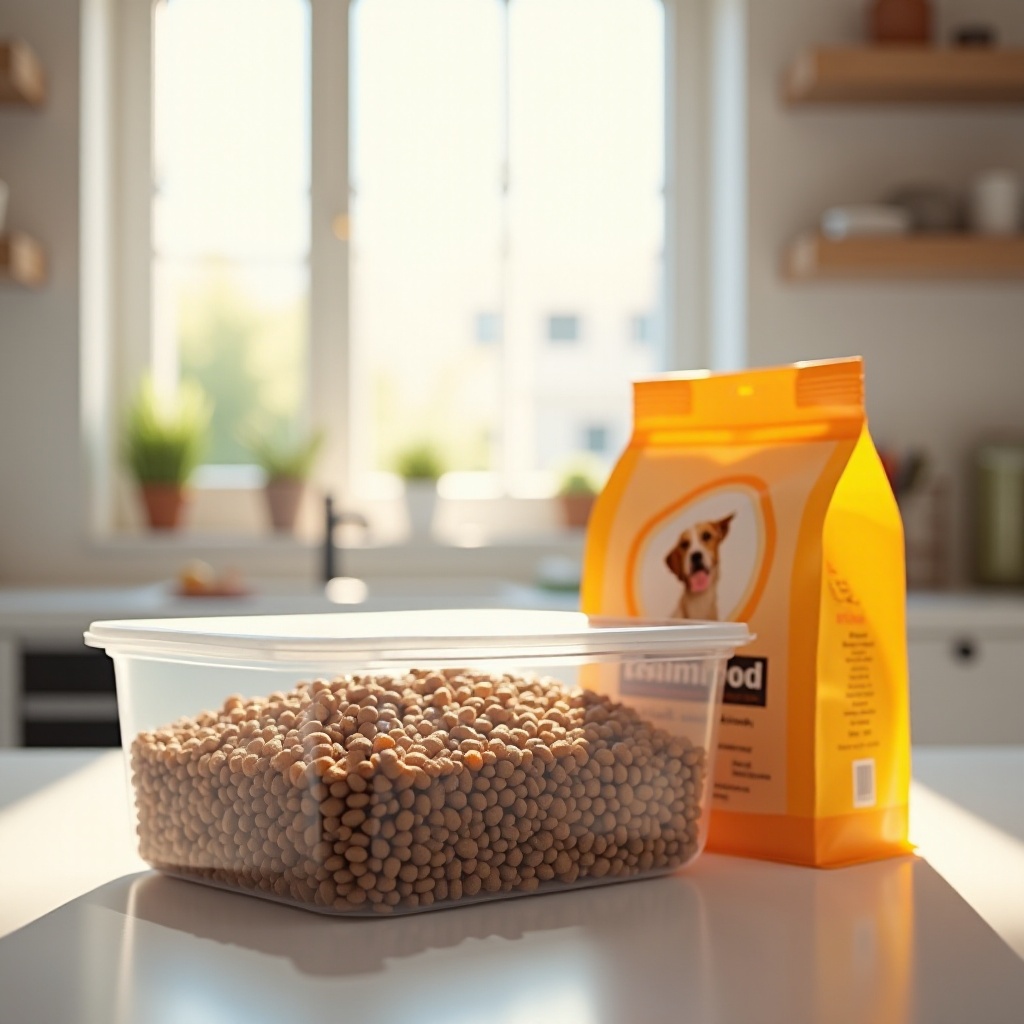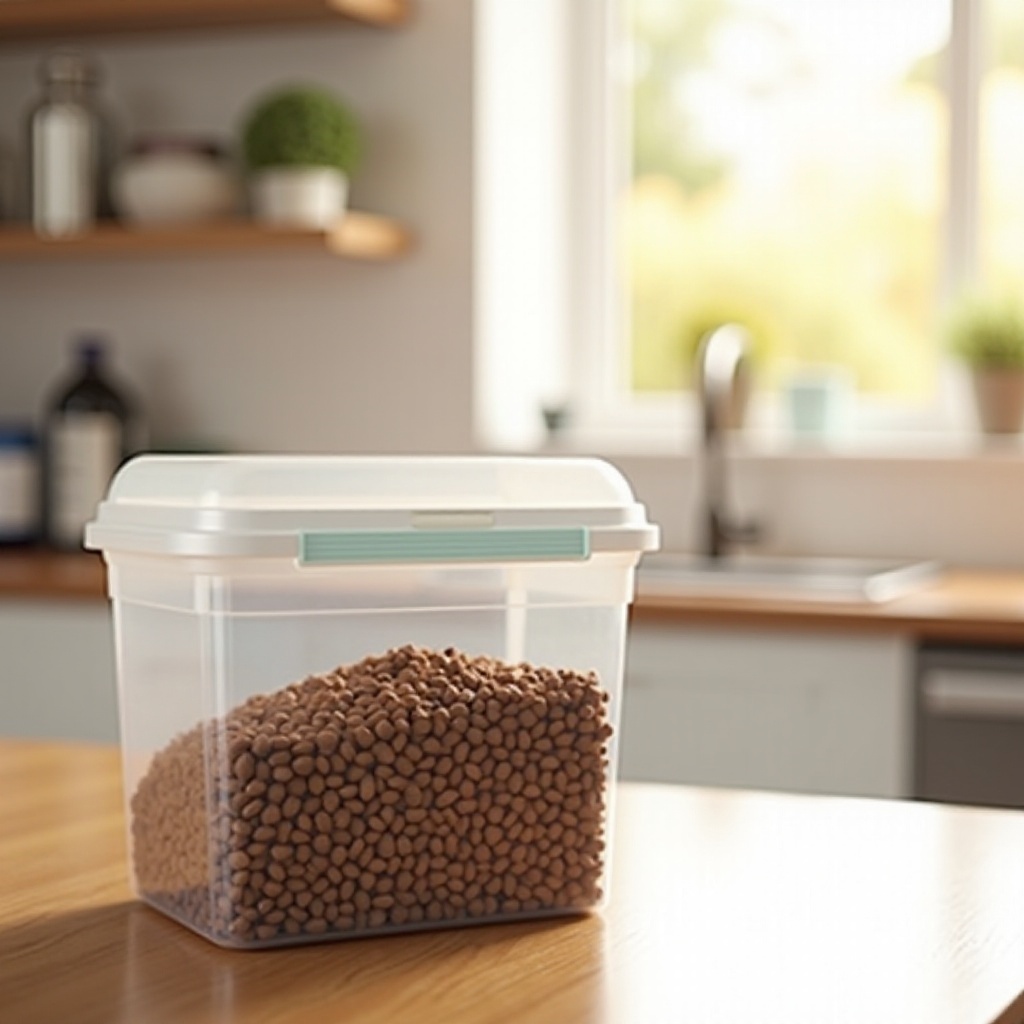Introduction
Storing dog food properly is crucial for your pet’s health. Pet owners often wonder about the best way to keep their dog’s food fresh and safe. One common question arises: Should you store dog food in a plastic container? This article will delve into the different aspects of dog food storage, specifically focusing on the use of plastic containers. We will explore why proper storage matters, the pros and cons of plastic containers, alternative storage solutions, and the best practices for maintaining freshness and safety. By the end of this article, you will have a clear understanding of the right way to store your furry friend’s food.

Why Proper Dog Food Storage Matters
Ensuring proper storage for dog food isn’t merely a matter of convenience. Proper storage is essential for maintaining nutritional value and preventing contamination. When dog food is exposed to air, moisture, and light, it can lead to the degradation of essential nutrients. Additionally, improper storage can lead to mold growth, infestations by pests, or the food becoming rancid.
Owners might not realize that food exposed to these elements can compromise their dog’s health. A bad diet can result in gastrointestinal issues, loss of appetite, and other more severe health problems. By understanding the importance of proper dog food storage, pet owners can better care for their dogs and contribute to a healthier, happier life.
Understanding Dog Food Storage Requirements
Dog food manufacturers often provide guidelines for proper storage on their packaging. Typically, dry dog food should be kept in a cool, dry place and sealed tightly to avoid exposure to air and moisture. Wet dog food, on the other hand, should be refrigerated after opening and used within a certain timeframe.
Several factors influence the storage requirements for dog food, including temperature, humidity, and exposure to light. Extreme temperatures or high humidity can significantly shorten the shelf life of pet food. Moreover, continuous exposure to light can degrade the nutrients within the food.
For dry kibble, the original packaging is often designed to maintain freshness and keep out moisture. These bags are specially made with fat barriers to keep the food fresher for longer. Still, additional measures, like transferring the kibble to an airtight container, can provide an extra layer of protection.

Pros of Storing Dog Food in Plastic Containers
Storing dog food in plastic containers can offer several advantages, making it a popular choice among pet owners:
- Convenience: Plastic containers often come with easy-to-use lids, making access to the dog’s food quick and hassle-free.
- Space-Efficiency: These containers come in various sizes, ideal for different storage spaces and quantities. They are often designed to be stackable, saving valuable space in the pantry.
- Portability: Plastic containers are generally lightweight, making them easy to move around. This feature is especially useful if you travel with your pet.
- Airtight Sealing: High-quality plastic containers often have airtight seals, which help keep the food fresh by protecting it from air and moisture.
- Affordability: Compared to other storage solutions, plastic containers are usually more cost-effective and widely available.
By utilizing these types of containers, pet owners can ensure their dog’s food remains safe and retains its nutritional quality for a longer period.

Cons of Storing Dog Food in Plastic Containers
While plastic containers offer numerous benefits, there are also some downsides to consider:
- Chemical Leaching: Over time, some plastics can leach chemicals into the food, potentially posing health risks. This is particularly true if the plastic container is not food-grade.
- Odor Retention: Plastic can sometimes retain odors, which could be unpleasant when switching between different types of food.
- Static Cling: Dry dog food can create static electricity inside plastic containers, which may cause particles and oils to stick to the sides. This can lead to strain when cleaning and potential contamination if not properly washed.
- Durability Issues: Plastic containers can crack or break more easily than some other materials, leading to potential contamination risks if the container is compromised.
- Environmental Impact: Plastic is not as environmentally friendly as other materials like glass or metal. Disposing of or recycling plastics can contribute to ecological concerns.
With these factors in mind, it’s crucial for pet owners to weigh the pros and cons based on their storage needs and priorities.
Alternative Storage Solutions
Considering the downsides, pet owners might seek alternative storage solutions that can also maintain the freshness and safety of their pet’s food. Here are some options:
- Metal Containers: Metal containers, especially stainless steel, are highly durable, often airtight, and can efficiently protect food from light and moisture. They are also easier to clean and less likely to retain odors.
- Glass Jars: Glass containers offer a non-toxic alternative to plastic. They do not absorb odors or leach chemicals, making them a healthier choice. However, they can be heavier and more prone to breaking.
- Original Packaging with Sealing Clips: Keeping the food in its original packaging and using a sealing clip can maintain the food’s freshness and nutritional value. The original bags are designed to lock in the food’s nutrients and typically come with a fat barrier that provides added protection.
- Vacuum-Sealed Bags: Vacuum-sealing removes air from the storage bag, helping to keep the food fresh for more extended periods. This method is excellent for wet food that has been opened and needs to be portioned.
- Ceramic Containers: A stylish yet functional option, ceramic containers can also keep dog food fresh. They are non-toxic and can help maintain a consistent interior environment for the food.
Choosing the right storage solution may depend on various factors like the type of food, storage space, and personal preferences regarding sustainability and convenience.
Best Practices for Storing Dog Food in Plastic Containers
If you decide to use plastic containers for storing dog food, follow these best practices to ensure the food remains safe and fresh:
- Use Food-Grade Containers: Always opt for containers labeled as food-grade to minimize risks of chemical leaching.
- Airtight Sealing: Ensure the container has a tight seal to prevent air and moisture from getting in. This step is crucial in maintaining freshness.
- Store in a Cool, Dry Place: Keep the container in a location that is cool and dry, away from direct sunlight and heat sources.
- Keep the Original Packaging: If possible, place the entire bag of dog food inside the plastic container. This double layer of protection keeps oils and fats from sticking to the container and preserves the food’s integrity.
- Regular Cleaning: Clean the container thoroughly before refilling it with new food. This process helps prevent contamination and buildup of oils and fats from old food residues.
By following these practices, you can effectively use plastic containers without compromising your dog’s health.
Conclusion
Deciding whether to store dog food in plastic containers requires weighing the pros and cons. While plastic containers offer convenience and affordability, concerns about chemicals, odors, and environmental impact must be taken into account. Exploring alternative storage options like metal, glass, or vacuum-sealed bags can provide safer and more sustainable choices. Whichever method you choose, following best practices for food storage is essential to keep your pet’s food fresh and healthy.
Frequently Asked Questions
Are plastic containers safe for storing dog food?
Yes, provided you use food-grade plastic containers. These are designed to store food safely and minimize the risk of chemical leaching.
How often should I clean the plastic container?
It’s recommended to clean the plastic container every time you refill it with new dog food. Regular cleaning prevents contamination from residue, oil, and fats from the old food.
What are the best alternatives to plastic containers?
Alternative storage options include metal containers, glass jars, the dog food’s original packaging with sealing clips, vacuum-sealed bags, and ceramic containers. Each option has its benefits, depending on your priorities around safety, environment, and convenience.
